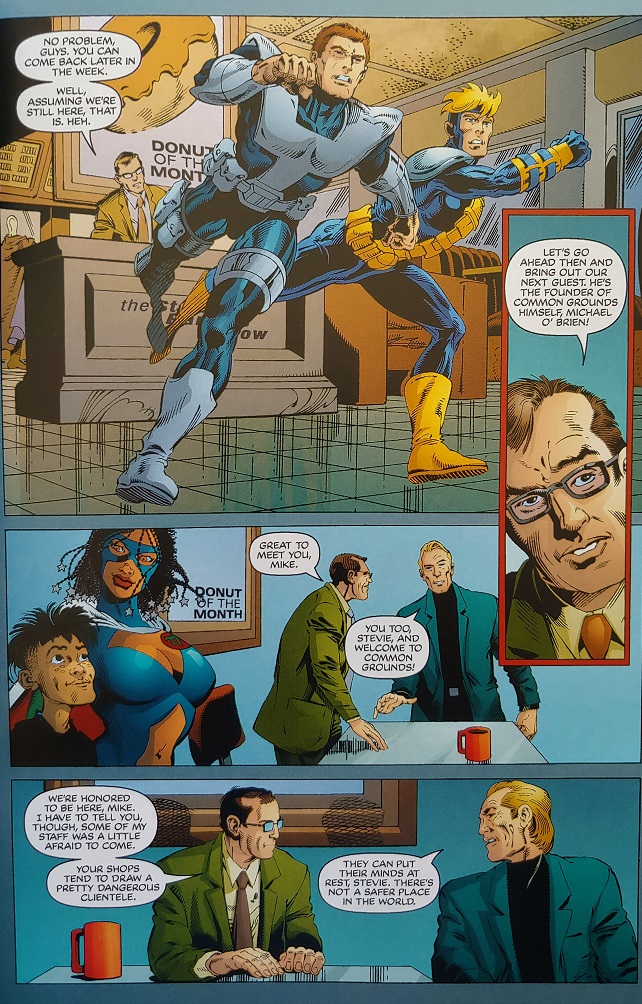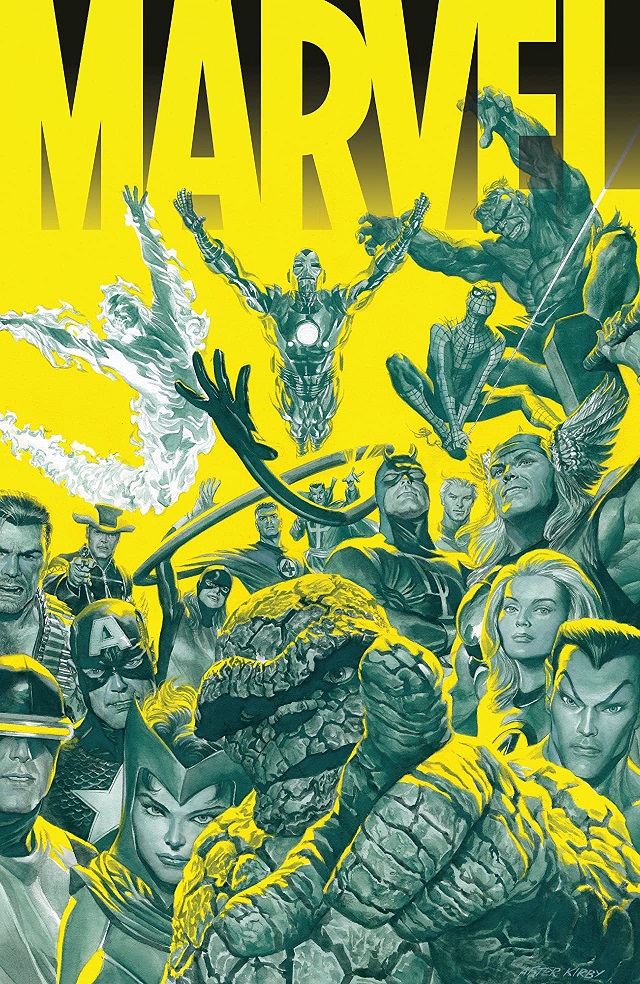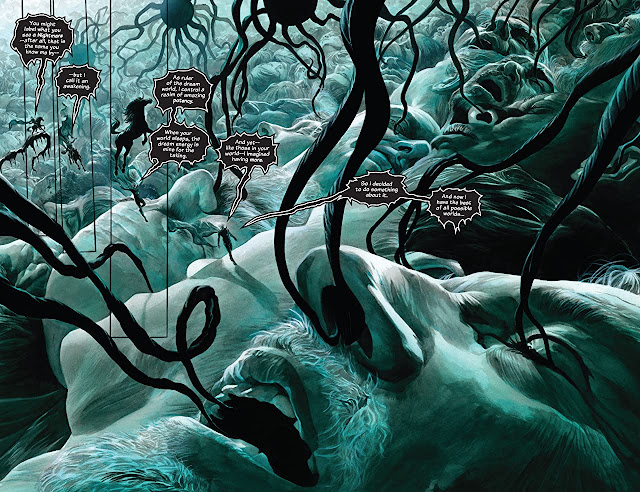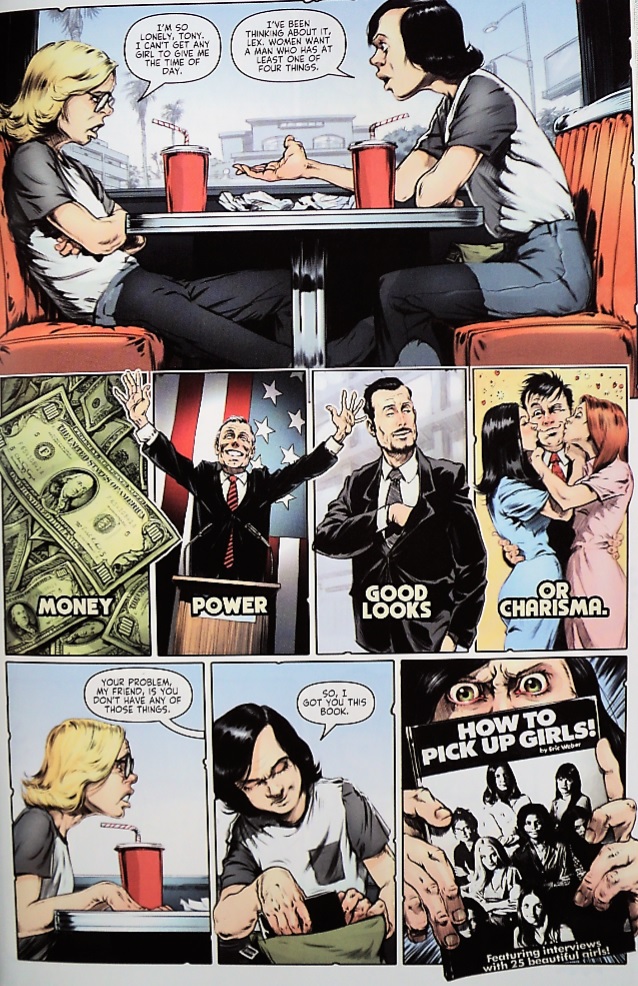If we’re lucky some comic books come to us exactly at the right moment in our lives. Over a year ago, I was visiting Davis comic book store, and I found the first 5 issues of Common Grounds (the sixth and last one, I had to track down on my own). As soon as I started reading issue # 1 I was hooked. Troy Hickman is an amazing writer and what he did in this Image / Top Cow miniseries is an accomplishment worthy of the best days of Busiek’s Astro City.
It sure took me a while to review the whole miniseries, but what I started many months ago it’s coming to an end now. In “American Pi” (July 2004), Hickman works with famous artist Sam Kieth, whose notable work not only includes Sandman but also other more personal creations such as The Maxx. So far, in the Common Grounds universe we haven’t seen a hero akin to Captain America, someone who upholds the ideals of the nation and not the divisive politics. However, even if she has her heart in the right place, some people don’t seem to agree.
In an inspired speech, the protagonist of this story tries to convince an angry mob of the fact that the US, with all its flaws and problems, is still the land of opportunity, it’s still the place where you get a chance to improve your life. I’d say that when writing this story Hickman was probably thinking of John F Kennedy’s popular quote: “do not ask what your country can do for you, but what can you do for your country”. Although it’s difficult to delve deep into superheroes, patriotism and politics in a handful of pages, I’d say the result here is pretty good.
In “Loose Ends”, the second story, we get to see a TV show in which Michael O’Brian, the founder of Common Ground, is about to be interviewed. In a heartfelt confession, O’Brian recalls his past as a superhero and how proud he felt when his son, despite the lack of superpowers, donned a superhero costume to carry on with the family tradition; unfortunately, a tragic accident cost him his life. The grieving father then decided to start with the concept of a coffee shop that would always be a symbol of truce and an oasis of peace for superheros and supervillains.
The last story was illustrated by Dan Jurgens, a man responsible for drawing the main Superman titles for almost a decade. Here Jurgens proves again why he’s one of the best superhero artists in the business. The cover of Common Grounds # 6 is by Rodolfo Migliari, an Argentinian artist whose stunning images channelize the best of Alex Ross. And this is the end. Hopefully one day soon Troy Hickman and the fantastic creative team that worked with him will return to Common Grounds. We definitely need more comics like these!
________________________________________________________________________________________________________
________________________________________________________________________________________________________
Si tenemos suerte, algunos cómics nos llegan exactamente en el momento adecuado de nuestras vidas. Hace más de un año, estaba visitando la tienda de cómics de Davis y encontré los primeros 5 números de Common Grounds (el sexto y último, tuve que buscarlo por mi cuenta). Tan pronto como comencé a leer el número 1, quedé enganchado. Troy Hickman es un escritor asombroso y lo que hizo en esta miniserie de Image / Top Cow es un logro digno de los mejores días del Astro City de Busiek.
Vaya que me tomó tiempo reseñar toda la miniserie, pero lo que comencé hace muchos meses ahora está llegando a su fin. En “Pi americano” (julio de 2004), Hickman trabaja con el famoso artista Sam Kieth, cuyo notable trabajo no sólo incluye a Sandman sino también otras creaciones más personales como The Maxx. Hasta ahora, en el universo de Common Grounds no hemos visto un héroe similar al Capitán América, alguien que defienda los ideales de la nación y no las divisiones políticas. Sin embargo, incluso si tiene el corazón en el lugar correcto, algunas personas no parecen estar de acuerdo.
 |
| Dan Jurgens |
En un discurso inspirado, la protagonista de esta historia trata de convencer a una turba enfurecida del hecho de que Estados Unidos, con todos sus defectos y problemas, sigue siendo la tierra de las oportunidades, sigue siendo el lugar donde tienes la oportunidad de mejorar tu vida. . Diría que al escribir esta historia, Hickman probablemente estaba pensando en la cita popular de John F. Kennedy: “no preguntes qué puede hacer tu país por ti, sino qué puedes hacer tú por tu país”. Aunque es difícil profundizar en los superhéroes, el patriotismo y la política en un puñado de páginas, diría que el resultado aquí es bastante bueno.
En “Cabos sueltos”, la segunda historia, vemos un programa de televisión en el que Michael O'Brian, el fundador de Common Grounds, está a punto de ser entrevistado. En una sentida confesión, O'Brian recuerda su pasado como superhéroe y lo orgulloso que se sintió cuando su hijo, a pesar de la falta de superpoderes, se vistió de superhéroe para continuar con la tradición familiar; desafortunadamente, un trágico accidente le costó la vida. Entonces, el afligido padre decidió comenzar con el concepto de una cafetería que siempre sería un símbolo de tregua y un oasis de paz para superhéroes y supervillanos.
 |
| Dan Jurgens |
La última historia fue ilustrada por Dan Jurgens, un hombre responsable de dibujar los principales títulos de Superman durante casi una década. Aquí Jurgens demuestra nuevamente por qué es uno de los mejores artistas de superhéroes de la industria. La portada de Common Grounds #6 es de Rodolfo Migliari, un artista argentino cuyas impactantes imágenes canalizan lo mejor de Alex Ross. Y este es el final. Con suerte, algún día Troy Hickman y el fantástico equipo creativo que trabajó con él volverán a Common Grounds. ¡Definitivamente necesitamos más cómics como estos!








































